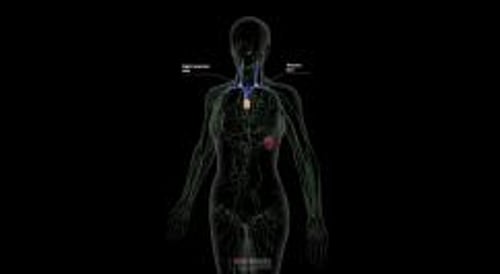Topic Resources
Plasma, along with some white blood cells, routinely moves out of capillaries into the interstitial space. Most of the fluid and its constituents is taken up by tissue cells or reabsorbed into the vascular tree, depending on the balance of hydrostatic and oncotic pressures. However, some of the fluid, along with certain cells and cellular debris (eg, from the immune response to local infection, cancer, inflammation) enters the lymphatic system.
Like the venous system, the lymphatic system consists of a multitude of thin-walled vessels that transport fluid throughout the body. Small lymphatic vessels empty into larger ones that ultimately drain into the central venous system via the thoracic duct or the right lymphatic duct. Most lymphatic vessels have valves, similar to those in veins, that keep lymph flowing in one direction (toward the heart). Unlike the venous system, in which fluid (blood) is pumped by the heart, lymph is propelled by pressure generated during muscle contraction.
Before entering the central venous system, lymph passes through lymph nodes, which filter out cellular material, including cancer cells, and foreign particles. Lymph nodes also are key participants in the immune system because they are packed with lymphocytes, macrophages, and dendritic cells that are poised to respond to any antigens transported from tissues in the lymph.
Lymph nodes are categorized as
Superficial: Superficial nodes are located just below the skin; they are present throughout the body, but particular collections are present in the neck, axillae, and groin.
Deep: Deep lymph nodes are located in the abdominal or thoracic cavity.
Disorders of the lymphatic system
Disorders of the lymphatic system involve ≥ 1 of the following:
Obstruction
Infection or inflammation
Cancer
Obstruction leads to accumulation of lymphatic fluid in tissues (lymphedema) and is usually secondary to surgery, radiation therapy, injury, or, in tropical countries, lymphatic filariasis. Rarely, the cause is a congenital disorder (see Primary lymphedemas).
Infection or inflammation may cause reactive lymph node enlargement (lymphadenopathy). The nodes themselves may become infected (causing lymphadenitis) by organisms spread through the lymphatic system from the primary site of infection.
Various cancers may metastasize to local or regional lymph nodes. Rarely, a primary cancer (eg, lymphangiosarcoma) develops in the lymphatic system.




